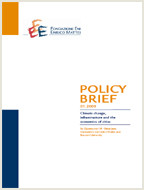Post 2012 Climate Architectures: A Comparative Assessment
In July 2009 the G8 set a goal of cutting emissions of greenhouse gases by 80% by 2050, calling for worldwide emissions to be halved by the same date. Since then, China and India have expressed what have seemed more open positions towards the idea of reducing emissions, while the US appears, on the other hand, to be lowering its expectations on what will come out from the next round of negotiations. Although it is widely understood that no single country can address the climate change problem on its own, the international effort has apparently run into an insurmountable roadblock.
The prospect of this Policy Brief is to discuss some of the major proposals, put forward by scholars and policy makers, to find practical solutions to these apparently irreconcilable differences. The brief is based on the quantitative work done by the WITCH (World Induced Technical Change Hybrid) modelling team, which aimed at comparing some of the main architectures for an agreement on climate policy. Possible successors to the Kyoto protocol are assessed according to four criteria: economic efficiency; environmental effectiveness; distributional implications; and their political acceptability which is measured in terms of feasibility and enforceability. The ultimate aim is to derive useful information for designing a future agreement on climate change control.

